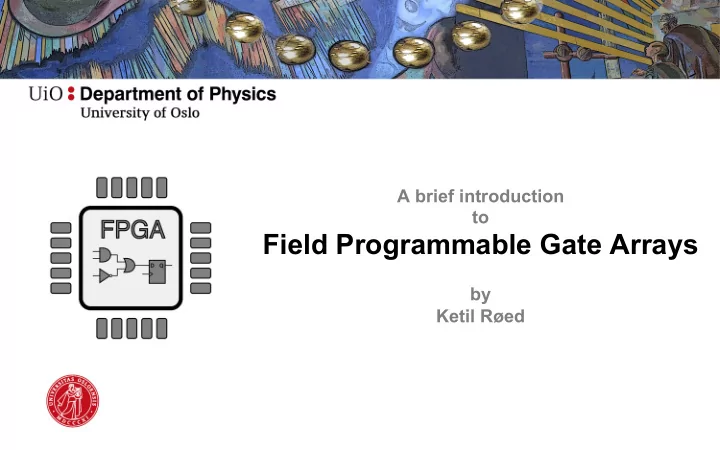

A brief introduction to Field Programmable Gate Arrays by Ketil Røed
Field Programmable Gate Array • Integrated circuit including a matrix of general-purpose programmable logic I I I I I I I I I I I I I I I I I I I I O O O O O O O O O O O O O O O O O O O O blocks. SET D Q logic logic logic logic logic logic D SET Q block block block block block block Q CLR Q RAM RAM • Functions described by a Hardware CLR Description Language (VHDL, Verilog) logic logic logic logic logic logic logic block block block block block block block and mapped into pre-existing programmable logic (Configuration) RAM RAM logic logic logic logic logic logic logic block block block block block block block • True parallelism ( concurrency) I I I I I I I I I I I I I I I I I I I I O O O O O O O O O O O O O O O O O O O O
Programmable logic block Combinational logic Logic block Boolean logic LUT A y B C MUX D q DFF clk Switch matrix Synchronous / Sequential logic
Look-Up Table (LUT) A0 A1 A1 A0 M 0 0 0 0 0 0 1 0 1 0 0 1 0 0 1 0 0 1 1 1 1 1 Two input AND-gate
Configuration bits e.g. SRAM M Configuration memory (LUT, ) It defines the logic function and routing Switch matrix Logic block LUT A y B C MUX M M M M D q DFF clk M M M Additional FPGA resources (JTAG, POR, PLLs,etc)
Intel Adaptive Logic Module More info in Altera white paper “FPGA architecture”: https://www.altera.com/en_US/pdfs/literature/wp/wp-01003.pdf
From design to configuration Bit stream generated Configure 0101000101 device 0101011000 0101011110 1010010010 Bit value stored in Configuration memory cell SRAM/ FLASH
High level synthesis (HLS) • Automated process that interprets an algorithmic description of a desired behavior in a high-level development tool/language and creates digital hardware that implements that behavior. – C-code (development tool) – Matlab (HDL coder) – LabView (FPGA module) • Advantage: – Easy to implement complex designs with e.g. mathematical operations and filters. • Disadvantage: – Less control of the more complex HDL code.
FPGAs and Processors • Hard-core: – Modern FPGAs have Hard Processor Systems embedded in Silicon in addition to the programmable logic part. • Soft-core: – Also possible to implement a CPU in HDL (soft-core)
Why FPGAs? • Reconfigurable • Short time to market (quick response to market demands) • Excellent and low-cost choice for prototyping • True parallelism with high I/O count • High reliability, determinism & performance • Can replace microcontrollers in designs with – A demand for high number & flexible I/O lines – A need for non-standard user interfaces • Offers single chip solutions (SoC) Icons by www.pngrepo.com
Application
The answer is not always FPGAs • Can be expensive compared to microcontrollers • Often higher power consumption compared to microcontrollers • High pin count => complex packaging (BGA) • Complicated (i.e. clocking and timing) • Complex tools • HDL not necessarily easy or intuitive • Often a microcontroller can do the job!
Main FPGA vendors
Summary • Introduction to Field Programmable Gate Arrays • Programmable logic block • Look-up table • Hardware Description language and how an FPGA can be configured • Some advantages and disadvantages
Recommend
More recommend